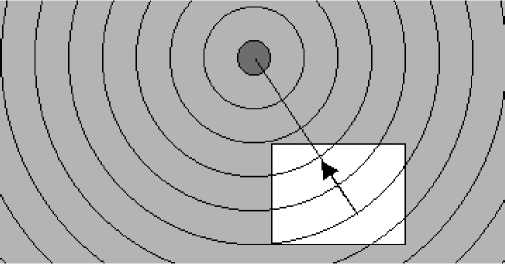19
pointing time should become independent of view size (Equation 7). All three experiments
used the same basic experimental protocol, which we first describe.
5.1. Methods
5.1.1. The Document
We had to circumvent a common problem of zooming interfaces, known as desert fog: one
gets lost if one zooms-in an empty region of a multiscale document (Jul & Furnas, 1998).
Since we were interested in the basic sensory-motor processes involved in target reaching,
rather than the higher cognitive processes of orientation, we used a document designed to
preclude disorientation. We used an electronic map containing nothing but an infinite set of
equidistant concentric circles centered around the target. Zooming-in caused a radial
expansion, and zooming-out a radial shrinking of the current document selection around the
screen center, but the number of visible arcs displayed in the document was held roughly
constant due to a self-similar fractal generation mechanism. When the target was out of sight
(as in Figure 17), our participants always knew in what direction and how far they had to
move their view, since target direction was specified by the perpendiculars to the tangents to
the visible arcs and target distance by arc curvature, the inverse of the radius D.

Figure 17. A schematic illustration of the array of concentric circles with the target located out of sight.
The view, shown as an empty rectangle, intercepts four arcs which specify target direction and distance.
The radius and the arrow, not shown in the experimental display, appear here for explanatory reasons.
We had recourse to semantic zooming (Perlin & Fox, 1993; Furnas & Bederson, 1995). As
long as the magnification was insufficient to allow target representation, a constant-size (i.e.,
zoom-insensitive) beacon represented the target. As soon as, thanks to zooming-in, the target
could be displayed with more than one screen pixel, it replaced the beacon, the document then
revealing a colored disc that was zoomable and could be clicked.
5.1.2. Input device
Zooming was controlled with the left, non-preferred hand by rotating a game-controller
throttle. Panning was controlled with the right, preferred hand by operating a mouse (in
Experiment 1) or a Wacom stylus set to the relative mode (in Experiment 2). For both
zooming and panning, the control was in zero-order mode (i.e., angles were directly converted
into scale levels, and positions into positions, respectively).
There was no cursor. A stationary crosshair permanently shown at the center of the view
served for aiming, as in shooting games. Moving the panning device with the right hand
More intriguing information
1. Poverty transition through targeted programme: the case of Bangladesh Poultry Model2. Rent-Seeking in Noxious Weed Regulations: Evidence from US States
3. Getting the practical teaching element right: A guide for literacy, numeracy and ESOL teacher educators
4. Does adult education at upper secondary level influence annual wage earnings?
5. Fiscal Reform and Monetary Union in West Africa
6. The name is absent
7. The economic value of food labels: A lab experiment on safer infant milk formula
8. The name is absent
9. The name is absent
10. Integration, Regional Specialization and Growth Differentials in EU Acceding Countries: Evidence from Hungary